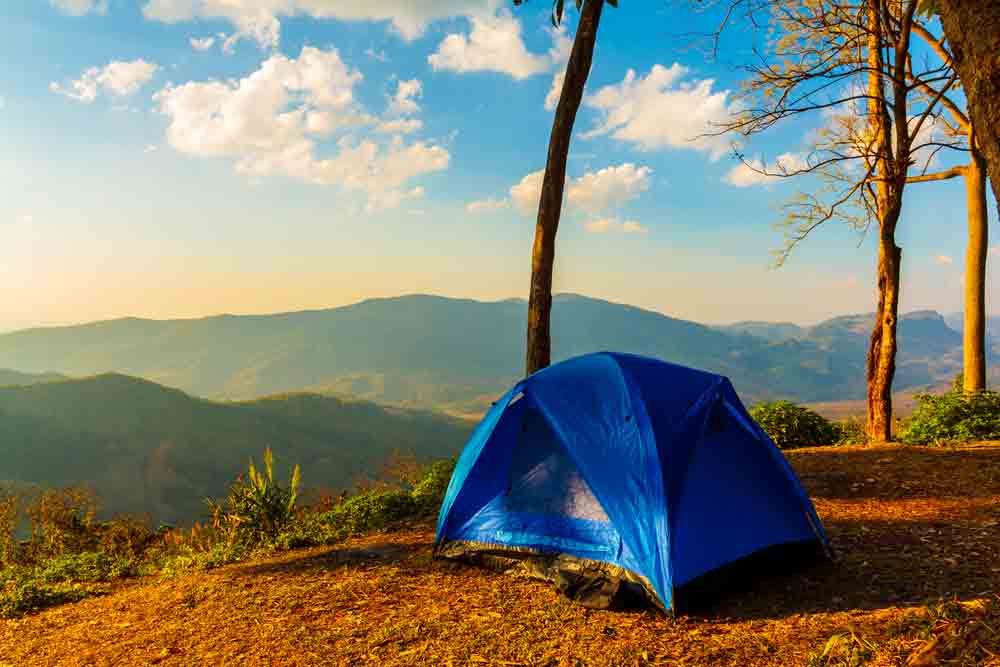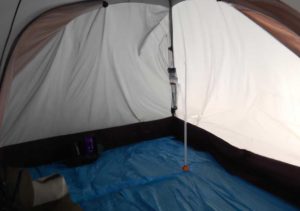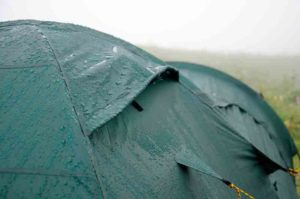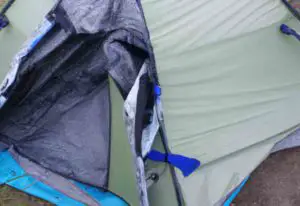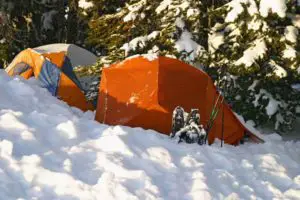A backpacking tent footprint is a piece of fabric that is designed to go under your backpacking tent. It serves two main purposes: it protects the bottom of your tent from abrasion and it keeps the bottom of your tent dry.
Many people choose to forgo using a footprint because they think it’s an added expense that they don’t need. However, we believe that a footprint is a necessary piece of gear for anyone who wants to protect their investment in a backpacking tent. In this blog post, we will discuss the benefits of using a backpacking tent footprint and why you should consider purchasing one!
Types of Footprints for Backpacking Tent
When you are looking for a backpacking footprint, you will want to make sure that it is specifically designed for the model of tent that you have. Some companies make generic footprints that can be used with any type of tent, but we recommend getting one that is made specifically for your tent. This will ensure the best fit and protection for your tent.
There are two main types of footprints: those with a bathtub floor and those without a bathtub floor.
A footprint with a bathtub floor extends up the sides of your tent, providing extra protection from water and mud. This is a good option if you frequently camp in wet conditions or if you want the added peace of mind of knowing that your tent floor has an extra layer of protection.
A footprint without a bathtub floor does not extend up the sides of your tent and is typically lighter weight. This is a good option if you are primarily concerned with protecting the bottom of your tent from abrasion and want to save on weight.
Why Use a Backpacking Tent Footprint?
There are several reasons why you should use a backpacking tent footprint, even if your tent already has a waterproof bottom.
First, a footprint will protect the bottom of your tent from abrasion. If you frequently set up your tent on rocky or gravel surfaces, a footprint will help to extend the life of your tent by protecting the tent floors from being scratched or punctured.
Second, a footprint will help to keep the bottom of your tent dry. Even if your tent has a waterproof bottom, water can seep in through the seams or zippers and wet the floor of your tent. A footprint will create an additional barrier between the forest floor and your tent, helping to keep the tent floor dry.
Finally, a footprint will help to insulate your tent from the cold ground. In colder weather, you can place a sleeping pad on top of your footprint to create an extra layer of insulation between you and the ground. This can help you stay warmer at night and get a better night’s sleep.
If you are considering purchasing a backpacking tent, we strongly recommend also buying a footprint. A backpacking tent footprint is a relatively inexpensive piece of gear that can help to protect your investment and extend the life of your tent. When choosing a footprint, make sure to select one that is specifically designed for the model of tent that you have.
How Much Does a Footprint Weigh, Exactly?
The weight of a footprint will vary depending on the size and material, but most footprints weigh between 12 and 20 ounces (340-565 grams). For reference, an iPhone XS weighs about six ounces (170 grams). Tent footprint material is typically made from polyethylene or nylon.
A typical three-person backpacking tent weighs around four pounds (1814 grams), so a footprint adds less than two percent to the total weight of your shelter system.
When Should You Use a Groundsheet vs. A Footprint?
A groundsheet is a piece of fabric that you place under your tent floor to protect the bottom from abrasion and moisture. Groundsheets are typically made from thicker, more durable fabrics than tent footprints, and they usually weigh more.
A tent footprint is a piece of fabric that you place under your tent to protect the bottom from abrasion and moisture. Footprints are typically made from thinner, lighter-weight fabrics than groundsheets, and they usually weigh less.
So, when should you use a groundsheet vs. a footprint? If you are primarily concerned with protecting the bottom of your tent from abrasion, a groundsheet is a good option. If you are primarily concerned with protecting the bottom of your tent from moisture, a footprint is a good option. If you are concerned with both, you can use both a groundsheet and a footprint.
Most backpacking tents come with a Groundsheets are typically used in cold weather to create an extra layer of insulation between you and the ground. In warm weather, they can be used to protect the bottom of your tent from abrasion and moisture.
How to Make Your DIY Footprint?
If you’re looking to save some money, you can make your DIY footprint. To do this, you’ll need a piece of fabric that is slightly larger than the floor of your tent. We recommend using a lightweight, waterproof fabric such as Tyvek or nylon.
Cut the fabric to size and then seal the edges with a seam sealer to prevent water from seeping in. Once the seam sealer is dry, you’re ready to use your DIY footprint.
When using a DIY footprint, be sure to place it under your tent before setting it up. This will help to protect the bottom of your tent from abrasion and moisture.
How Do You Use a Tent Footprint?
A footprint is placed under your tent before setting up. This will help to protect the bottom of your tent from abrasion and moisture. When choosing a spot to set up your tent, look for a level spot that is free of debris such as sticks and rocks. If you are using a groundsheet, place it on top of the footprint. If you are using a footprint, place it under the tent.
When setting up your tent, be sure to stake out the corners of the footprint. This will help to keep it in place and prevent it from moving around. Once your tent is set up, you can remove the stakes.
If you are using a groundsheet, you can leave it in place. If you are using a footprint, you can remove it and store it in your tent.
When packing up your tent, be sure to clean the bottom of your tent before storing it. This will help to prevent dirt and debris from getting on the footprint.
Tent Manufactures Footprints vs DIY Footprints
Tent footprints are available for purchase from most tent manufacturers. These are typically made from lightweight, waterproof fabrics such as Tyvek or nylon.
Diy footprints can be made from a variety of materials. We recommend using a lightweight, waterproof fabric such as Tyvek or nylon.
When choosing a footprint, be sure to select one that is slightly larger than the floor of your tent. This will help to ensure that it covers the entire bottom of your tent and prevents water from seeping in.
Be sure to seal the edges of your footprint with a seam sealer to prevent water from seeping in. Once the seam sealer is dry, you’re ready to use your DIY footprint.
Do I Need a Tent Footprint when Backpacking?
A camping footprint is a ground cloth that goes under your tent to protect the bottom of the tent from dirt, moisture, and sharp objects. Many people find them helpful in preventing their tent from getting wet and dirty. However, they are not necessary for most backpacking tents and can add extra weight to your pack. If you choose to bring one along, make sure it’s made specifically for your tent model.
Is It Worth Getting a Footprint for A Tent?
Yes, footprints can extend the life of your tent and also protect the bottom from sharp objects and abrasion.
A footprint is essentially a groundsheet – a sheet of fabric that you put down on the ground before pitching your tent. It offers protection from the ground up, stopping water and moisture from saturating the base of your tent and stopping mud from coming through into the living area.
Most footprints are made from tough, waterproof polyethylene or nylon fabrics and are available in various shapes and sizes to fit the most popular tents. Some manufacturers make them integral to the design of their tents, for others, they are an optional extra.
What Size Should a Tent Footprint Be?
The size of a tent footprint should be relative to the size of the tent. For example, a three-person tent requires at least a 9-square-foot area, while an eight-person tents need an area double that size. footprints can be created out of tarp material, nylon, or polyethylene sheeting.
The material is placed on the ground under the tent, and prevents wear and tear on the bottom of the tent. In some cases, LIKE with rooftop tents it also serves as an insulator from heat or cold coming up from the ground. Many camper companies will sell you a specifically sized footprint for your model of the tent along with gear like stakes and rain covers.
Can I Use the Pool Underneath Instead Footprint?
No, the pool liner is not meant to be a ground cloth and will not provide the same protection as a footprint. The pool liner is also not treated to be waterproof or prevent abrasion. We recommend using tarp, nylon, or polyethylene sheeting for your footprint.
Do I Need a Tent Footprint when Car Camping?
A camping footprint is not necessary when car camping. However, it can extend the life of your tent and also protect the bottom from sharp objects and abrasion.
If you choose to bring a footprint along, make sure it’s made specifically for your tent model. The size of a tent footprint should be relative to the size of the tent. For example, a three-person tent requires at least a nine-square-foot area, while an eight-person tents need an area double that size. footprints can be created out of tarp material, nylon, or polyethylene sheeting.
Can I Use a Tarp as A Footprint?
Yes, you can use a tarp as a footprint. Be sure to select a tarp that is slightly larger than the floor of your tent. This will help to ensure that it covers the entire bottom of your tent and prevents water from seeping in.
Be sure to seal the edges of your footprint with a seam sealer to prevent water from seeping in. Once the seam sealer is dry, you’re ready to use your DIY footprint.

